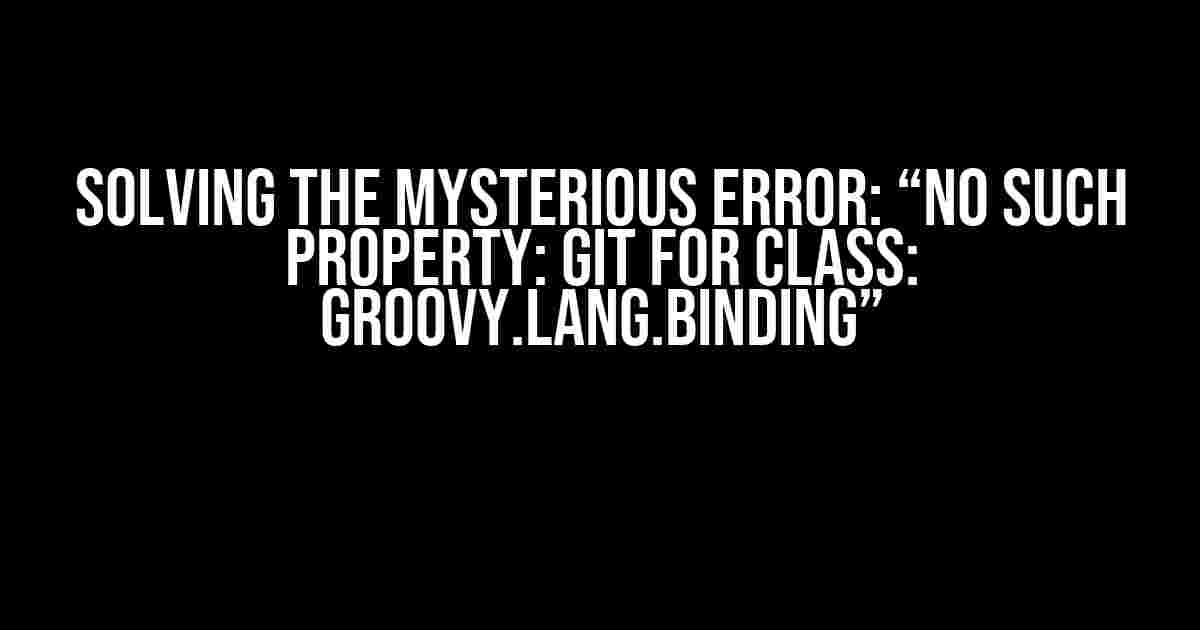Are you tired of staring at the frustrating error message “No such property: git for class: groovy.lang.Binding” when trying to run a function from an imported Groovy library? You’re not alone! This article will guide you through the troubleshooting process, providing clear explanations and step-by-step instructions to get you back on track.
Understanding the Error
Before diving into the solution, let’s break down the error message:
"No such property: git for class: groovy.lang.Binding"
This error indicates that the Groovy runtime is unable to find a property named “git” within the scope of the current script. But what does this mean, exactly?
The Culprit: Groovy’s Binding Class
In Groovy, the `Binding` class represents the script’s runtime environment. It’s responsible for storing and resolving variables, properties, and methods within the script. When you import a Groovy library, the classes and methods within that library become part of the script’s binding.
In this case, the error suggests that the `git` property or method is not found within the binding. But why?
Common Causes of the Error
Let’s explore some common scenarios that might lead to this error:
- Missing or incorrect import statements: Make sure you’ve imported the necessary Groovy libraries and classes correctly.
- Typo or incorrect method name: Double-check that you’re using the correct method name and syntax.
- Library version conflicts: Ensure that you’re using compatible versions of the Groovy libraries and dependencies.
- Script runtime issues: Problems with the script’s runtime environment, such as mismatched classloaders or incorrect configuration.
Troubleshooting Steps
- Verify import statements:
import groovy.lang.GroovyObject import groovy.util.GroovyScriptEngine // Import other required libraries and classesDouble-check that you’ve imported all necessary libraries and classes. Make sure you’re using the correct import statements and that they’re properly formatted.
- Check for typos and incorrect method names:
def result = git.clone('https://github.com/user/repo.git') // Instead of: def result = Git.clone('https://github.com/user/repo.git')Review your code for any typos or incorrect method names. Ensure that you’re using the correct capitalization and syntax.
- Verify library versions and dependencies:
Library Version Groovy 3.0.9 Git 2.30.1 Check that you’re using compatible versions of the Groovy libraries and dependencies. You can check the version numbers in your project’s build file (e.g., `build.gradle` or `pom.xml`) or by using the `groovy -v` command.
- Check script runtime configuration:
def binding = new Binding() def shell = new GroovyShell(binding) shell.evaluate(new File('script.groovy'))If you’re running your script programmatically, ensure that the script runtime environment is properly configured. Verify that the `Binding` instance is correctly set up and that the `GroovyShell` is evaluating the script correctly.
- Test the script in isolation:
// Create a new script with only the problematic code def testScript = ''' def result = git.clone('https://github.com/user/repo.git') println result ''' def testBinding = new Binding() def testShell = new GroovyShell(testBinding) testShell.evaluate(testScript)Create a new script that only contains the problematic code and test it in isolation. This will help you determine if the issue is specific to the script or related to the larger project.
Advanced Troubleshooting Techniques
If the previous steps didn’t resolve the issue, it’s time to dive deeper:
Enable Debug Logging
groovy -Dgroovy.debug=true -cp ./lib/* your_script.groovy
Enable debug logging for the Groovy runtime to get more detailed information about the error. This can help you identify the root cause of the issue.
Use a Debugger
groovy -cp ./lib/* -Xdebug -Xrunjdwp:transport=dt_socket,server=y,suspend=y,address=5005 your_script.groovy
Use a debugger like IntelliJ IDEA or Eclipse to step through the code and inspect variables and expressions. This can help you pinpoint the exact location and cause of the error.
Conclusion
Solving the “No such property: git for class: groovy.lang.Binding” error requires a combination of attention to detail, methodical troubleshooting, and a solid understanding of Groovy’s runtime environment. By following the steps outlined in this article, you should be able to identify and resolve the underlying cause of the error.
Remember to stay calm, take your time, and don’t hesitate to seek help if you’re still stuck. Good luck, and happy coding!
Keyword takeaway: When dealing with the “No such property: git for class: groovy.lang.Binding” error, focus on verifying import statements, checking for typos and incorrect method names, ensuring compatible library versions, and configuring the script runtime environment correctly.
Frequently Asked Question
Got stuck with Groovy? Don’t worry, we’ve got you covered! Here are some frequently asked questions about running functions from imported Groovy libraries.
Why am I getting “No such property: git for class: groovy.lang.Binding” error?
This error occurs when the Git library is not properly imported or initialized in your Groovy script. Make sure to add the @Grab annotation at the top of your script to import the necessary Git library, and then initialize the Git object before using it.
How do I import a Groovy library in my script?
To import a Groovy library, you can use the @Grab annotation at the top of your script, followed by the library’s Maven coordinates. For example, @Grab(‘org.ajoberstar.grgit:grgit:3.3.1’) would import the Grgit library.
What is the difference between @Grab and import in Groovy?
The @Grab annotation is used to download and import a library at runtime, while the import statement is used to import a class or package that is already available in the classpath. Use @Grab when you need to import a library that is not already available in your classpath.
Why is my script not recognizing the imported library?
This could be due to a variety of reasons, including incorrect Maven coordinates, network connectivity issues, or conflicts with other libraries. Check the Maven coordinates, ensure you have a stable internet connection, and try to isolate the issue by commenting out other imported libraries.
How do I troubleshoot issues with imported Groovy libraries?
To troubleshoot issues with imported Groovy libraries, start by checking the script’s output for any error messages, then review the Maven coordinates, and finally, try to isolate the issue by commenting out other imported libraries or scripts.

